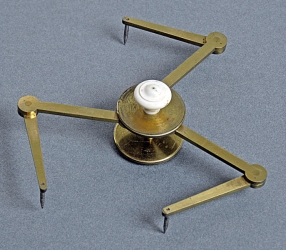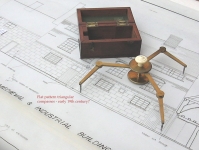Scientific Instrument Society 25th Anniversary Exhibition
Navigation:
<< First | < Previous | Next > | Last >>
14 Triangular Compass
My reasons for collecting drawing instruments have complex threads. Perhaps my grandfather’s skill at painting numerals on watch and clock dials has an influence; or my self-taught work carrying out archaeological drawings, for both site records and publication. Also, my interest in graphical art, like my print of an eighteenth century sea battle from a copper engraving; or perhaps the consummately illustrated, albeit of an out-of-date style for today’s taste, my 1860 volume of ‘The Practical Draughtsman’s Book of Industrial Design’, by William Johnson; where one can enthuse over drawings that include the intricate wheels and cogs of an industrial flour mill, the elegance of a suspension bridge, or perhaps the schoolboy’s choice of an impressive Ten-Wheeled Double Bogie Tank Passenger Locomotive, on a fold-out page. Most of these interests and illustrations involve skills with mainly drawing instruments. My collecting preferences are various, but largely depend on condition, completeness, uniqueness, or of special interest, and the all-important cost factor! My three contributions to this exhibition are special items, extracted from a collection of mainly run-of-the-mill instruments but still relating to historic elements of the draughtsman’s skills that I admire.
Triangular compasses can be used to transfer three points on a map or drawing to another sheet of paper or drawing. Today there is one main type, the upright three-legged version illustrated in numerous instrument makers’ catalogues, and on Plate I, Fig. N, of George Adams ‘Geometrical and Graphical Essays’ 1791. On the same page Adams draws attention to another form, the horizontal or flat version illustrated in Plate III, Fig. 12.
The compasses exhibited here are of the latter type and are a rare survival from the late 18th century. There is no maker’s signature but I would not rule out George Adams Jnr. (1750-1795) as the maker of this instrument. The compasses come in two separate parts and fit in a small felt-lined mahogany box with hook fasteners.
These triangular compasses were added to my collection despite having read the outpourings against them by William Ford Stanley (1829-1909) in the Preface to his Treatise on Drawing Instruments, where they are described as ‘A very silly triangular compass’, and he was uncertain if the instrument was ever made!
Like my other two exhibits, this instrument stands out from the ordinary instruments in the personal assemblage I call ‘my collection’.
See: W.F. Stanley, A Descriptive Treatise on Mathematical Drawing Instruments, London 1868.
Collection: John Bateman, Yorkshire
Objects lent by John Bateman, Yorkshire:
15. Sumeter Scale, by Charles Suffell, London, 1839-1865
16. Marquois Set, by William Harris, London, Early 19th Century


